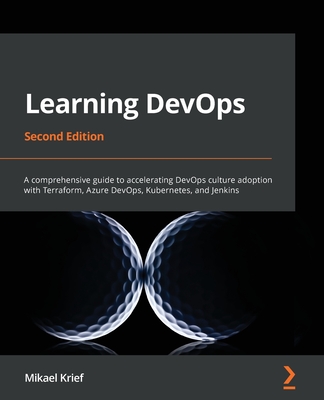買這商品的人也買了...
-
 無瑕的程式碼-敏捷完整篇-物件導向原則、設計模式與 C# 實踐 (Agile principles, patterns, and practices in C#)
無瑕的程式碼-敏捷完整篇-物件導向原則、設計模式與 C# 實踐 (Agile principles, patterns, and practices in C#)$790$616 -
 Working Effectively with Legacy Code : 管理、修改、重構遺留程式碼的藝術 (中文版)
Working Effectively with Legacy Code : 管理、修改、重構遺留程式碼的藝術 (中文版)$720$562 -
 $477Rust 權威指南 (The Rust Programming Language (Covers Rust 2018))
$477Rust 權威指南 (The Rust Programming Language (Covers Rust 2018)) -
 再強一點:用 Go語言完成六個大型專案 (書況差限門市銷售)
再強一點:用 Go語言完成六個大型專案 (書況差限門市銷售)$780$468 -
 $1,400Network Programming with Go: Learn to Code Secure and Reliable Network Services from Scratch
$1,400Network Programming with Go: Learn to Code Secure and Reliable Network Services from Scratch -
 黑帽 Python|給駭客與滲透測試者的 Python 開發指南, 2/e (Black Hat Python : Python Programming for Hackers and Pentesters, 2/e)
黑帽 Python|給駭客與滲透測試者的 Python 開發指南, 2/e (Black Hat Python : Python Programming for Hackers and Pentesters, 2/e)$450$356 -
 Spring REST API 開發與測試指南|使用 Swagger、HATEOAS、JUnit、Mockito、PowerMock、Spring Test
Spring REST API 開發與測試指南|使用 Swagger、HATEOAS、JUnit、Mockito、PowerMock、Spring Test$580$458 -
 Linux 網路內功修煉 - 徹底了解底層原理及高性能架構
Linux 網路內功修煉 - 徹底了解底層原理及高性能架構$780$663 -
 演算法生存指南(書況差限門市銷售)
演算法生存指南(書況差限門市銷售)$800$632 -
 從 Hooks 開始,讓你的網頁 React 起來 (第二版)(iT邦幫忙鐵人賽系列書)
從 Hooks 開始,讓你的網頁 React 起來 (第二版)(iT邦幫忙鐵人賽系列書)$720$562 -
 哎呀!不小心刻了一套 React UI 元件庫 : 從無到有輕鬆上手(iThome鐵人賽系列書)
哎呀!不小心刻了一套 React UI 元件庫 : 從無到有輕鬆上手(iThome鐵人賽系列書)$650$507 -
 The Rust Programming Language, 2/e (Paperback)
The Rust Programming Language, 2/e (Paperback)$1,800$1,710 -
 哎呀!原來 React 這麼有趣好玩:圈叉、貪吃蛇、記憶方塊三款經典遊戲實戰練習(iThome鐵人賽系列書)
哎呀!原來 React 這麼有趣好玩:圈叉、貪吃蛇、記憶方塊三款經典遊戲實戰練習(iThome鐵人賽系列書)$620$484 -
 Smaller C|用於小型機器之精實程式碼 (Smaller C: Lean Code for Small Machines)
Smaller C|用於小型機器之精實程式碼 (Smaller C: Lean Code for Small Machines)$680$537 -
 白話機器學習
白話機器學習$780$616 -
 React 思維進化:一次打破常見的觀念誤解,躍升專業前端開發者(iThome鐵人賽系列書)【軟精裝】
React 思維進化:一次打破常見的觀念誤解,躍升專業前端開發者(iThome鐵人賽系列書)【軟精裝】$790$616 -
 Python 風格徹底研究|超詳實、好理解的 Python 必學主題 (Dead Simple Python)
Python 風格徹底研究|超詳實、好理解的 Python 必學主題 (Dead Simple Python)$980$774 -
 遞迴演算法大師親授面試心法:Python 與 JavaScript 解題全攻略 (The Recursive Book of Recursion)
遞迴演算法大師親授面試心法:Python 與 JavaScript 解題全攻略 (The Recursive Book of Recursion)$680$530 -
 建構機器學習系統實踐指南
建構機器學習系統實踐指南$620$490 -
 機器學習的訓練資料 (Training Data for Machine Learning)
機器學習的訓練資料 (Training Data for Machine Learning)$780$616 -
 資料工程基礎|規劃和建構強大、穩健的資料系統 (Fundamentals of Data Engineering)
資料工程基礎|規劃和建構強大、穩健的資料系統 (Fundamentals of Data Engineering)$980$774 -
 讓 AI 好好說話!從頭打造 LLM (大型語言模型) 實戰秘笈
讓 AI 好好說話!從頭打造 LLM (大型語言模型) 實戰秘笈$680$537 -
 日式 RPG 編年史:從 DQ 到 FF,角色扮演遊戲敘事手法完全剖析
日式 RPG 編年史:從 DQ 到 FF,角色扮演遊戲敘事手法完全剖析$380$300 -
 軟體工程師的英語使用守則:English for Developers
軟體工程師的英語使用守則:English for Developers$420$357 -
 內行人才知道的系統設計面試指南 第二輯 (System Design Interview – An Insider's Guide: Volume 2)
內行人才知道的系統設計面試指南 第二輯 (System Design Interview – An Insider's Guide: Volume 2)$820$648
相關主題
商品描述
Follow this step-by-step guide for creating a continuous delivery pipeline using all of the new features in Jenkins 2.0 such as Pipeline as a Code, multi-branch pipeline, and more. You will learn three crucial elements for achieving a faster software delivery pipeline: a fungible build/test environment, manageable and reproducible pipelines, and a scalable build/test infrastructure.
Pro Continuous Delivery demonstrates how to create a highly available, active/passive Jenkins server using some niche technologies.
What You'll Learn
- Create a highly available, active/passive Jenkins server using CoreOS and Docker, and using Pacemaker and Corosync
- Use a Jenkins multi-branch pipeline to automatically perform continuous integration whenever there is a new branch in your source control system
- Describe your continuous delivery pipeline with Jenkinsfile
- Host Jenkins server on a cloud solution
- Run Jenkins inside a container using Docker
- Discover how the distributed nature of Git and the “merge before build” feature of Jenkins can be used to implement gated check-in
- Implement a scalable build farm using Docker and Kubernetes
Who This Book Is For
- You have experience implementing continuous integration and continuous delivery using Jenkins freestyle Jobs and wish to use the new Pipeline as a Code feature introduced in Jenkins 2.0
- Your source code is on a Git-like version control system (Git, GitHub, GitLab, etc.) and you wish to leverage the advantages of a multi-branch pipeline in Jenkins
- Your infrastructure is on a Unix-like platform and you wish to create a scalable, distributed build/test farm using Docker or Kubernetes
- You are in need of a highly available system for your Jenkins Server using open source tools and technologies
商品描述(中文翻譯)
請遵循這個逐步指南,使用 Jenkins 2.0 中的所有新功能來創建持續交付管道,例如 Pipeline as a Code、多分支管道等。您將學習到三個實現更快軟體交付管道的關鍵要素:可替代的建置/測試環境、可管理且可重現的管道,以及可擴展的建置/測試基礎設施。
專業持續交付展示了如何使用一些小眾技術創建一個高可用的主動/被動 Jenkins 伺服器。
您將學到什麼
- 使用 CoreOS 和 Docker 創建一個高可用的主動/被動 Jenkins 伺服器,並使用 Pacemaker 和 Corosync
- 使用 Jenkins 多分支管道,自動執行持續整合,當您的源代碼控制系統中有新分支時
- 使用 Jenkinsfile 描述您的持續交付管道
- 在雲解決方案上託管 Jenkins 伺服器
- 在容器中使用 Docker 運行 Jenkins
- 了解 Git 的分散式特性和 Jenkins 的「合併前建置」功能如何用於實現門檻檢查
- 使用 Docker 和 Kubernetes 實現可擴展的建置農場
本書適合誰
- 您有使用 Jenkins 自由作業實施持續整合和持續交付的經驗,並希望使用 Jenkins 2.0 中引入的新 Pipeline as a Code 功能
- 您的源代碼在類似 Git 的版本控制系統上(如 Git、GitHub、GitLab 等),並希望利用 Jenkins 中多分支管道的優勢
- 您的基礎設施在類 Unix 平台上,並希望使用 Docker 或 Kubernetes 創建可擴展的分散式建置/測試農場
- 您需要一個高可用的系統來支持您的 Jenkins 伺服器,並使用開源工具和技術
















